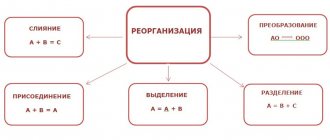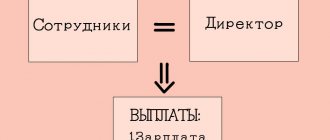Deposits of legal entities: main nuances and features
A deposit is an amount of money that is placed by a depositor in a bank for a certain period of time. The bank puts the depositor's funds into circulation, and for this pays the depositor interest on the deposit. The bank is obliged to return the funds (deposit) to the depositor upon expiration of the deposit period.
When concluding a contract, it is important to consider the following points:
- The period for placing the deposit is a long-term financial investment or a short-term financial investment (clause 1 of Article 837 of the Civil Code of the Russian Federation);
- Type of deposit – replenishable deposit or non-replenishable deposit;
- Conditions for early termination of the contract (clause 3 of Article 837 of the Civil Code of the Russian Federation);
- The procedure for calculating deposit interest: monthly capitalization or accrual of interest at the end of the deposit term;
- The procedure and terms for paying interest on the deposit (clause 1 of Article 839 of the Civil Code of the Russian Federation).
Accounting for bank deposit transactions
Deposit operations involve opening a deposit by concluding a deposit agreement between the parties, followed by depositing or transferring funds from the client’s (bank) account. Also, the bank needs to calculate the interest due on the deposit, then either add it to the principal amount of the deposit, or pay the client in cash through the cash desk or by bank transfer by transfer to the account.
Note 1
Interest is accrued and added in accordance with the terms of the deposit agreement. Interest may accrue or accrue at each accounting period or at the end of the contract term.
Then the credit institution issues or transfers the deposit amount with interest to the client, in cash or by bank transfer. This is how the deposit agreement is closed.
Note 2
If the depositor does not close the deposit agreement, the bank automatically transfers the agreement to the “on demand” status.
Let's consider the procedure for accounting for transactions on deposits for various groups of clients - legal entities, individuals, as well as credit institutions.
Finished works on a similar topic
- Course work Accounting for bank deposit operations 470 rub.
- Abstract Accounting for bank deposit operations 260 rub.
- Test work Accounting for bank deposit operations 210 rub.
Receive completed work or specialist advice on your educational project Find out the cost
Accounting for interest on deposits in accounting
In accounting, deposit amounts are taken into account as a financial investment, in accordance with clauses 2 and 3 of PBU 19/02, equivalent to the amount of funds placed by the depositor on deposit.
In accounting, interest on the deposit is reflected in subaccount 91.01 “Other income”. Interest on the deposit must be accrued on the last day of the reporting period. The amount of deposit interest is calculated according to the terms of the agreement (clause 34 of PBU 19/02, clause 7, clause 10.01 and clause 16 of PBU 9/99). In the event that the periods for accounting for accrued interest on a deposit in accounting and accounting records differ, in accounting the amount of interest is reflected as temporary differences, in accordance with PBU 18/02.
Early termination of the contract, return of the deposit
On 07/03/2017, the organization LLC “Trading House “Complex”” terminates the agreement for placement of a deposit with the credit institution ahead of schedule. To reflect this operation in the 1C: Accounting 8.3 program, create the document “Receipt to the current account” manually, go to Bank and cash desk/Bank statements/Receipt.
Fill out the document card that opens:
- “Account” – select account 51 “Current accounts”;
- “Which.” Number" and "In. Date” – indicate the number and date of the bank order;
- “Payer” – select our “PJSC Sberbank”;
- “Amount” – indicate the amount of our deposit: RUB 5,000,000.00;
- “Contract” – select with the “Other” view and the corresponding payment currency;
- DDS item – indicate “Return of deposit”;
- Settlement account – select subaccount 55.03 (Deposit accounts);
- In the payment purpose field: we indicate why the funds are being transferred to us, under what agreement;
- The “Settlement accounts” field is filled in automatically when you select the type of transaction in the document “Receipt to the current account”;
- Make a deposit in 1C (its return) and close.
Since the organization terminated the deposit agreement ahead of schedule, we need to recalculate the amount of interest at a reduced rate and reflect it in the program.
To do this, go to Operations/Operations entered manually/Create – select document type “Operation”.
Fill out the document card that opens:
- “From” – indicate the transaction accounting date 07/03/2017;
- “Content” – we specify the content of our operation;
- “Transaction amount” – indicate the amount of interest accrued for April, May, June, July 2021). The amount is calculated using the formula: RUB 30,479.45 = ((5,000,000* 2.5%)/365)*(26+31+30+2) where (2.5% reduced interest rate under the agreement, 365 number of days in a year, 26 number of days for April, 31 number of days for May, 30 number of days for June, 2 number of days for July).
Next, we need to indicate the transactions “for the calculation of bank interest” in the tabular part of the document.
Click the "Add in the table section" button.
Fill out the tabular part of the document:
- “Debit” - select subaccount 76.09 “Other settlements with various debtors and creditors”;
- “Subconto 2Dt” from the “Counterparties” directory, select our “PJSC Sberbank”;
- “Subconto 3Dt” – select the deposit agreement “55”;
- “Subconto 4Dt” – indicate the document for settlements with counterparties. In our example, this is “Write-off from current account 0000-000001 dated 04/05/2017”;
- “Credit”, select account 91.01 “Other income”;
- “Subconto Kt2” – DDS article “Interest receivable (paid)”;
- Record and close.
Tax accounting of interest on deposits
In tax accounting, the deposit amount is not recognized as an expense for tax purposes, in accordance with clause 12 of Article 270, clause 1 of Article 346.16 of the Tax Code of the Russian Federation.
In tax accounting, interest on a deposit is recognized as non-operating income and is included in income on the last day of the month, in accordance with clause 6 of Article 250 of the Tax Code of the Russian Federation; paragraph 1, 3, paragraph 6, article 271, paragraph 3, paragraph 4, article 328 of the Tax Code of the Russian Federation. Regardless of the terms of the agreement, the amount of deposit interest must be reflected monthly as part of taxable income.
There is no need to charge VAT on deposit interest amounts and keep separate records of input VAT, according to the Letter of the Ministry of Finance dated 10/04/2013. No. 03-07-15/41198, dated May 22, 2013. No. 03-07-14/18095 and Letter of the Ministry of Finance dated May 17, 2012. No. 03-07-11/145
Placing a deposit
To transfer money to a bank deposit, we will create the document “Write-off from the current account”, the operation “Issuing a loan to a counterparty”:
In the document we indicate:
Posting Dt 58.03 Kt 51 reflects the fact of transferring money to the deposit.
Postings for interest on deposits in accounting
Let's look in more detail at examples of how to reflect the accrual of interest on a deposit in transactions.
Example 1
The organization VESNA LLC transferred 500,000.00 rubles to the bank on March 1, 2021. for deposit. According to the terms of the agreement, the deposit period is 12 months, therefore, the bank must return the funds on February 28, 2021.
Interest on the deposit is accrued monthly at a rate of 9% per annum with monthly capitalization of interest. The total amount of accrued interest is paid at the end of the term along with the deposit amount.
Calculation of the amount of income, deposit and payment scheme for accrued interest on the deposit:
Postings for accounting for the deposit amount and interest on the deposit:
| Debit Account | Credit Account | Transaction amount, rub. | Wiring Description | A document base |
| 58 | 51 | 500 000,00 | VESNA LLC transferred funds to deposit | Bank statement |
| 58 | 91.01 | 3 750,00 | Interest accrued on the deposit for the month of March (500,000.00 * 9% /12) | Deposit agreement |
| 58 | 91.01 | 3 778,13 | Interest accrued on the deposit for the month of April ((500,000.00+3,750.00) * 9% /12) | |
| etc. | ||||
| 51 | 58 | 546 903,45 | The bank returned the deposit amount with the total amount of accrued interest (500,000.00+46,903.45) | Bank statement |
Example 2
The organization VESNA LLC transferred 500,000.00 rubles to the bank on March 1, 2021. for deposit. According to the terms of the agreement, the deposit period is 12 months, therefore, the bank must return the funds on February 28, 2021.
Simple interest on the deposit is accrued monthly at a rate of 9% per annum. Interest on the deposit is accrued starting from the day following the day of transfer of funds, including the day the bank returns the funds to the depositor.
Calculation of the amount of income, deposit and payment scheme for accrued interest on the deposit:
Postings for accounting for the deposit amount and interest on the deposit:
| Debit Account | Credit Account | Transaction amount, rub. | Wiring Description | A document base |
| 58 | 51 | 500 000,00 | Funds transferred to deposit | Bank statement |
| 76 | 91.01 | 3 750,00 | Interest accrued on the deposit for the month of March (500,000.00 * 9% /12) | Deposit agreement |
| 51 | 76 | 3 750,00 | The accrued interest on the deposit for March is listed | Bank statement |
| etc. | ||||
| 51 | 58 | 500 000,00 | The deposit amount was returned by the bank | Bank statement |
Basic accounting entries for deposit transactions
bank physical deposit interest
Attracted deposits are reflected in balance sheet accounts in sections 3 and 4 of Chapter A of the balance sheet of the credit institution. Deposit accounts are passive. Analytical accounting of raised funds (deposits) is carried out in the context of creditors, for each concluded agreement.
The chart of accounts provides for accounting of deposits according to the timing of their placement in the bank. At the same time, demand deposits and time deposits are distinguished. Time deposits are funds deposited with a bank for a certain fixed period, which requires appropriate reflection in the accounting records of a commercial bank.
Each of these accounts is divided into second-order accounts depending on the investment period:
Deposits on balance sheet account 426 “Deposits of non-resident individuals” are taken into account in the same way.
Demand accounts account for funds that are subject to return upon the depositor’s first request or upon the occurrence of a condition (event) stipulated by the agreement, the specific date of which is unknown.
Amounts are credited to the corresponding accounts by maturity at the time of the transaction. Grouping of invoices by due date must be done programmatically.
The credit balance on deposit accounts means the bank's debt on borrowed funds. Loan turnover reflects the amounts received from deposit owners for crediting to their accounts, as well as interest accrued on deposits, if the terms of the agreement provide for their addition to the deposit amount. The debit of the accounts reflects the payment of deposit amounts (and interest on it, if they are added to the deposit amount). Operations for crediting funds to deposit accounts and disbursing them from these accounts are carried out in correspondence with customer accounts and correspondent accounts of banks.
When an individual deposits cash into the bank's cash desk when opening a deposit, a cash receipt order is issued and the following entry is made:
Dt 20202 “Cash desk of credit institutions”
Kt423 (02—07) “Deposits of individuals.”
If funds on deposit are transferred non-cash from the depositor’s current account on the basis of a payment order, then the following transaction is made:
Dt 40817 “Current accounts”
Kt 423 (02—07) “Deposits of individuals.”
When returning the deposit amount upon expiration of the bank deposit agreement, reverse accounting entries are made:
a) Dt 423 (02–07) “Deposits of individuals”
Kt 20202 “Cash desk of credit institutions”;
b) Dt 423 (02—07) “Deposits of individuals”
Kt 40817 “Current accounts”.
In case of untimely return of deposits by the bank to individuals - the depositor, the posting is as follows:
Dt 423 (02—07) “Deposits of individuals”
Kt 476 (03-05) “Unfulfilled obligations under agreements to attract funds from clients - individuals.”
At the end of the contract, time deposits of citizens, if they are not claimed by depositors, are transferred to the accounts opened by them “on demand”:
Kt 42301 “Deposits of individuals” (“on demand”)
Dt 423 (02–07) “Deposits of individuals” (term).
or
Dt 40817 “Other accounts - individuals”
The accrual of interest on deposit (deposit) transactions is reflected in accounting by the following entry:
Dt 70606 “Expenses”
Kt 47411 “Accrued interest on deposits and funds raised by individuals”
Kt 47426 “Obligations to pay interest.”
When paying interest on a deposit to an individual in cash through a bank cash desk:
Kt 47411 “Accrued interest on deposits and funds raised by individuals”
Kt 20202 “Cash desk of credit institutions”.
When paying interest to an individual in non-cash form, the following transactions are possible:
a) Dt 47411 “Accrued interest on deposits and attracted funds of individuals”
Kt 42301 “Deposits of individuals” (“on demand”) - when the deposit expires and the account is closed;
b) Dt 47411 “Accrued interest on deposits and funds raised by individuals”
Kt 423 (02-07) “Deposits of individuals” (time) - when capitalizing interest, i.e. if interest is added to the deposit.
Calculation of interest on the balance
From the “Counterparties” directory, select the bank where we want to deposit the deposit. The type of agreement with the counterparty should be “Other”. The debit account is usually specified in 55.03 (“Deposit Accounts”).
As a result of transferring funds to the deposit, we receive posting 55.03 - 51. Return of the deposit Return of the deposit to the organization's current account is done with the document “Receipt to the current account.”
It is drawn up in the same way as the document “Write-off from the current account”. The same accounting account is indicated (55.03). Posting for the return of the deposit in return to receipt: 51 - 55.03. Accrual of interest on a deposit Accounting for the accrual of interest on a deposit is also reflected in the document “Receipt to the current account” with the type of transaction “Other”, only the “Settlement account” is indicated, as a rule, 91.01 (“Other income”). Accordingly, the posting for deposit interest will be formed 51 - 91.01.








